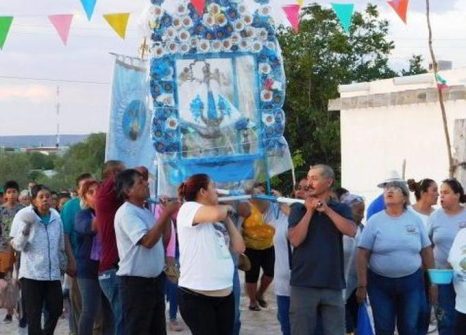The Last Campesinos in the Mexican Desert.

The small villages of the Tarahumara Indians in northern Mexico – where temperatures have risen above 50 degrees this year – have to deal not only with climate change, but also with injustice and discrimination. We accompany Brother Ricardo Greenley, a Jesuit, on one of his visits to Christian communities.
Sand and desert, villages and drought. This is the panorama that the populations of northern Mexico experience daily, resisting climate change that makes its presence felt forcefully. Brother Ricardo Greenley, Irish origins on his father’s side, Mexican on his mother’s side, a consecrated layman of the Society of Jesus, visits the farmers of the ejidos, villages where 20 to 30 families live, sharing their joys and difficulties. “I live in the state of Coahuila, a land on the border with Texas. I accompany the community of Parras in prayer, moving between the chapels of the parish”, he says. Driving his pick-up truck, he covers kilometres of road between General Cepeda and the Sierra Madre every week. In the village of Huariche, the farmers are waiting for him to pray to the Virgin of San Juan de Los Lagos in their chapel. After leaving the asphalt road, we enter among precarious huts and streets dug into the earth: at the end of the streets, the chapel appears painted blue and white, with paper decorations cut out by the women.

Ricardo Greenley, a Jesuit Brother. Facebook
Rural communities like Huariche are barely surviving and the missionaries are at their side. “Fewer and fewer people cultivate the land. The drought and the poverty of the means used have decimated the presence of farmers – he explains -. Many take the bus at dawn to the factories in Saltillo, the state capital, to work in the automobile and electronics industries. They return late at night, the villages become dormitories. The children live with their grandparents, the family breaks up, because even the mothers are away from home for work.”
It’s not the only problem in the Mexican North. This year, temperatures have risen above 50 degrees. Like much of the border with the United States, the state of Coahuila has a large percentage of desert territory: it no longer rains and working the fields is becoming increasingly difficult. The new landowners are buying up large plots of land. They extract water from underground – not always legally – and this further reduces water resources.
“Vineyards and walnut orchards are irrigated, but water is scarce in the villages. They make their crops rain with cloud seeding, a technique for stimulating rainfall by shooting jets of silver iodide or dry ice (solid carbon dioxide) into the sky with ground cannons.”
Climate change in this part of Mexico is seen in cities like Torreon or Saltillo, with a million inhabitants, which attract all the resources. Hotels with swimming pools and new vineyards pump the water that flows underground. While lecchuguilla, maguei and oregano – the native plants those farmers used to grow – disappear.

Procession in the village of Huariche in honour of the Virgin of San Juan de Los Lagos. Photo. MM
“Today the committee accompanies the Virgin Mary to one of the 52 ejidos of the parish”, Ricardo tells us, while passing through the village he greets a small group of men sitting in the shade.
“Ya viene tu Madre, date prisa”, he tells them from the window (Your Mother, the Virgin Mary, is coming, hurry).
With catechesis, celebrations and lots of dialogue, the Jesuits accompany the last inhabitants of these villages. Discussing social dynamics is a task that the religious carry out with the few and poor farmers who remain. “Evangelizing means knowing and following Jesus – Ricardo comments -. But here it also means defending life, people’s rights, human dignity, food, a roof, education, the land that must be protected”. He quotes the encyclical Laudato Si’, recalling that nearby cities are struggling to have more and more water resources while Conagua, the National Water Commission, already declared in 2020 that the extracted volume was greater than the recharge capacity.

Rarámuri girl runs to her house. CC BY-SA 4.0/Daniel Hernández Flores
The van crosses a vast territory, full of contrasts like all of Mexico. Green oases in the desert, thanks to the underground aquifers, stimulate the birth of latest-generation companies and vineyards. The denunciation of illegal drilling to the state authorities sees the missionaries alongside the farmers.Two kilometres from the chapel of Huariche, Greenley and the white-hatted campesinos are digging furrows in the ground. It is an experimental technique to encourage reforestation and increase the layer of humidity and silt. It will encourage the growth of trees, plants and vegetation. It is the path alongside these villages; with the Gospel, but also the seed of the earth, to hope that it will soon bear fruit again. (Open Photo: Indigenous Tarahumara man takes rest under the shade of the tree. Shutterstock/Svetlana Bykova)
Nicola Nicoletti/MM



